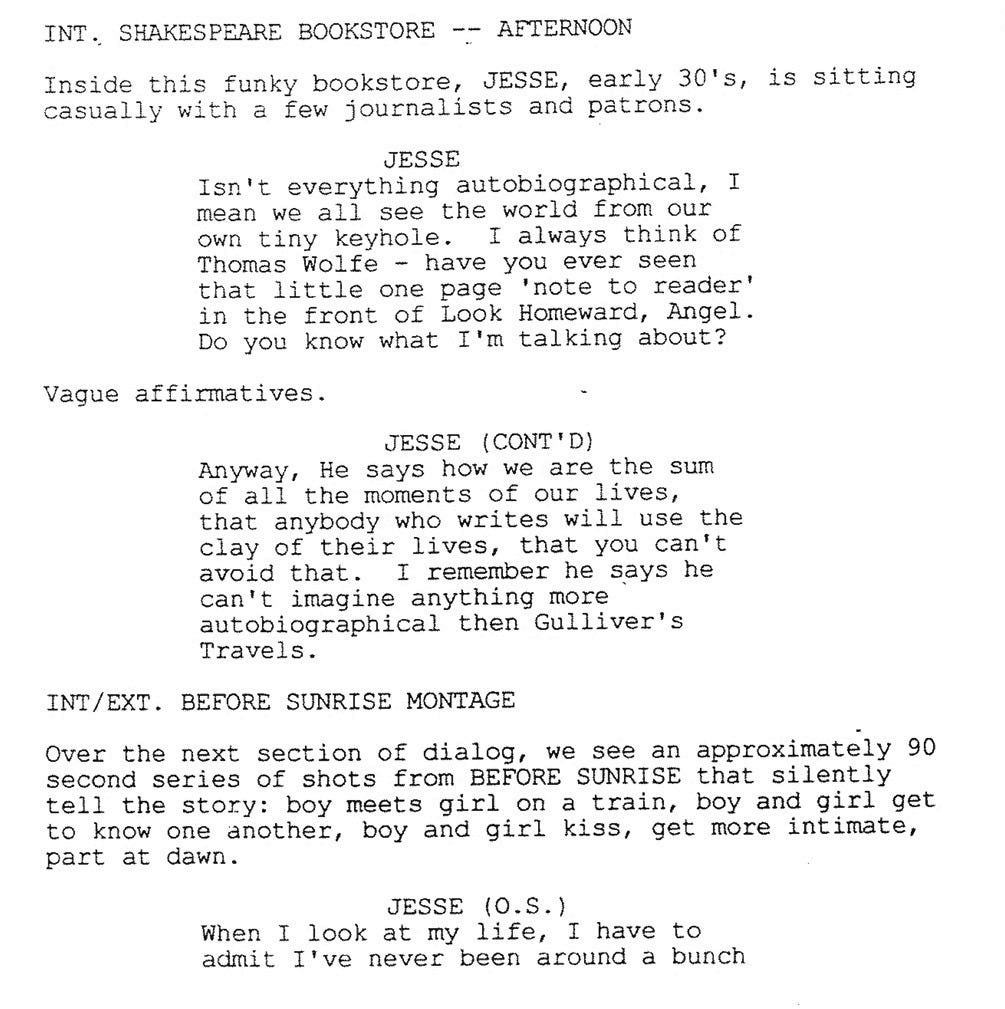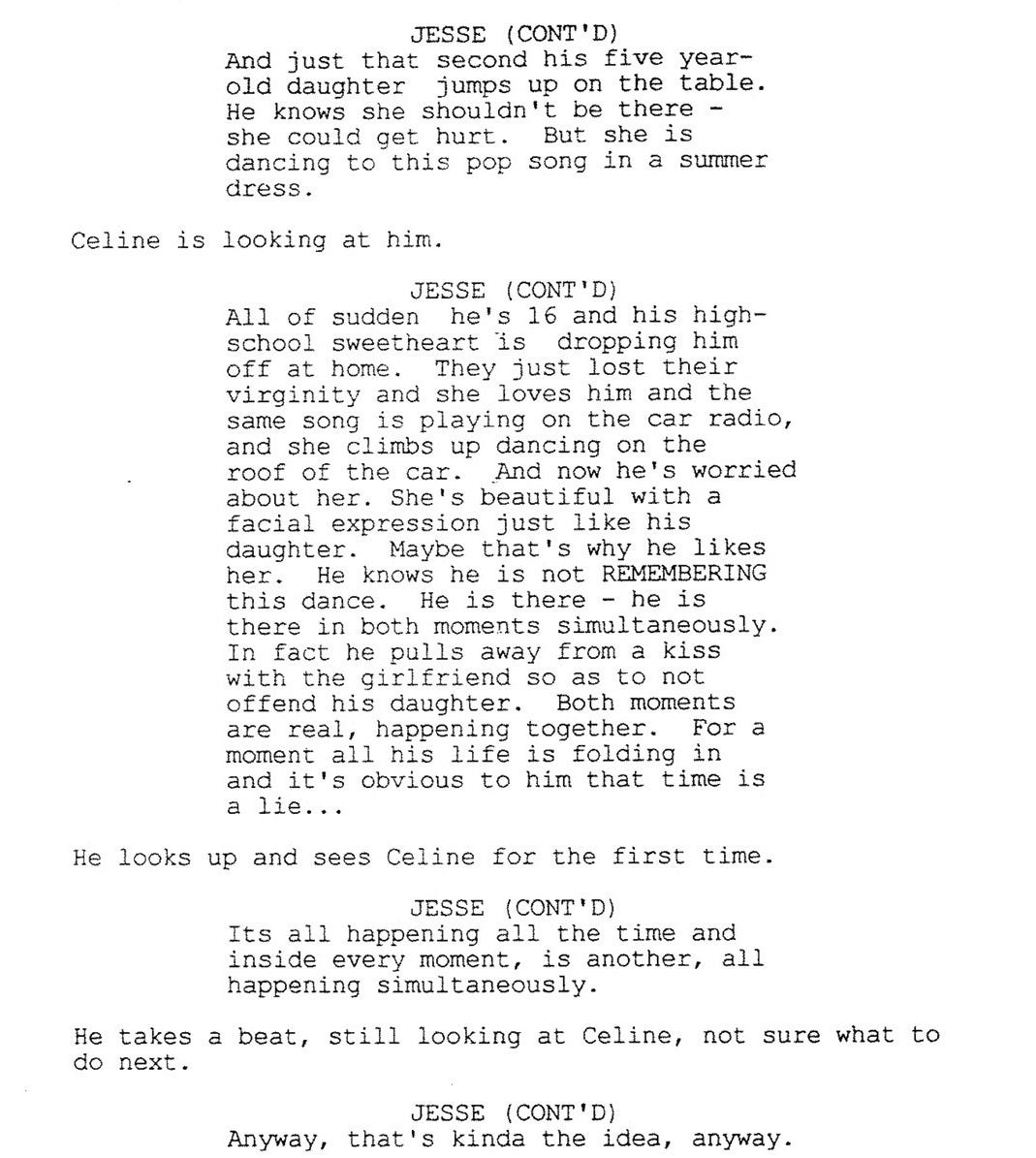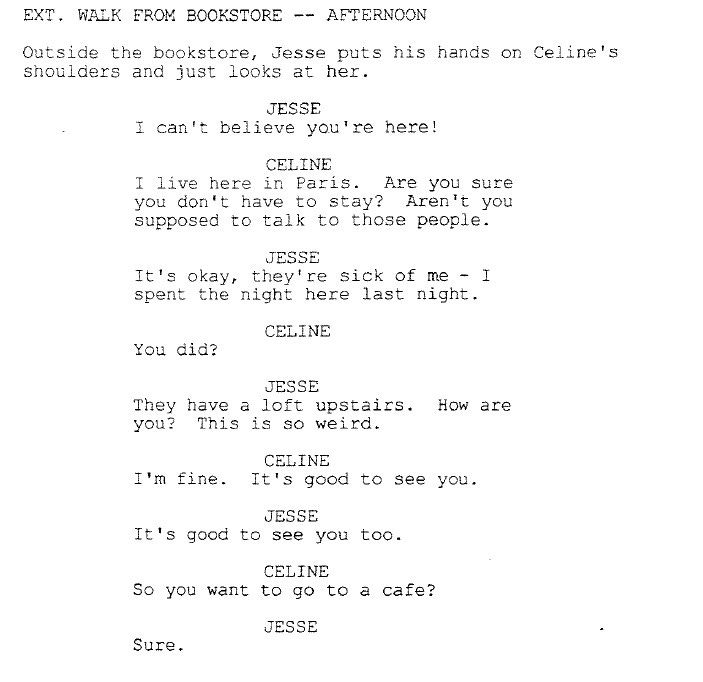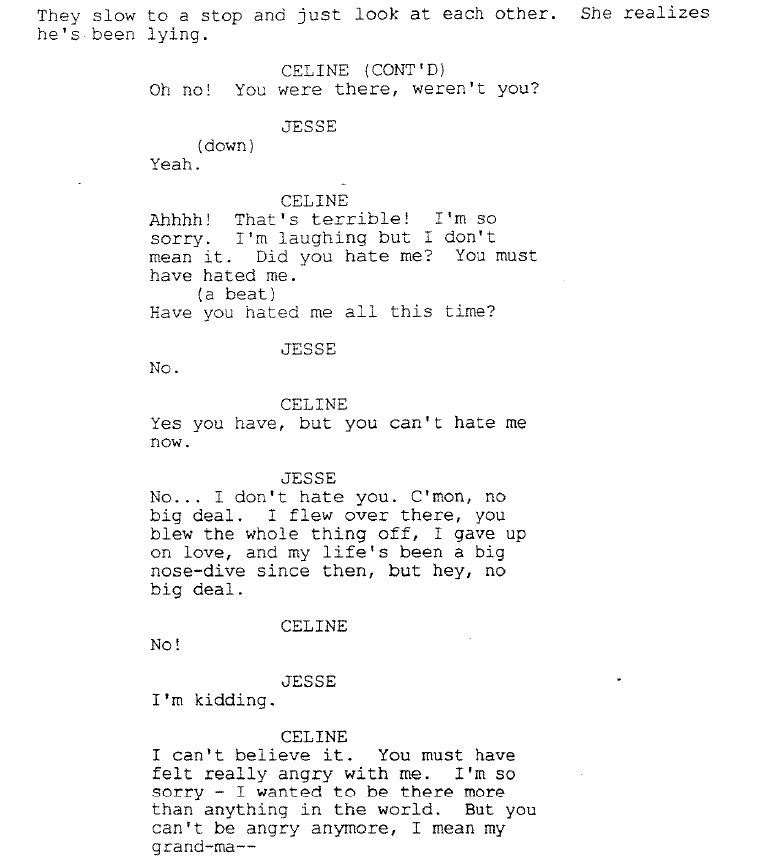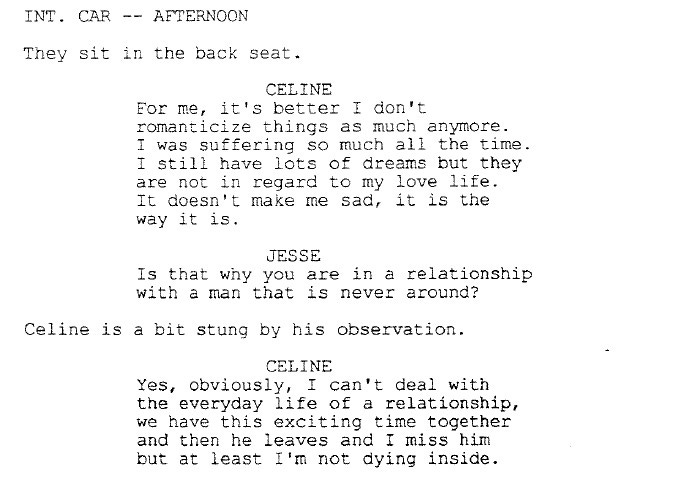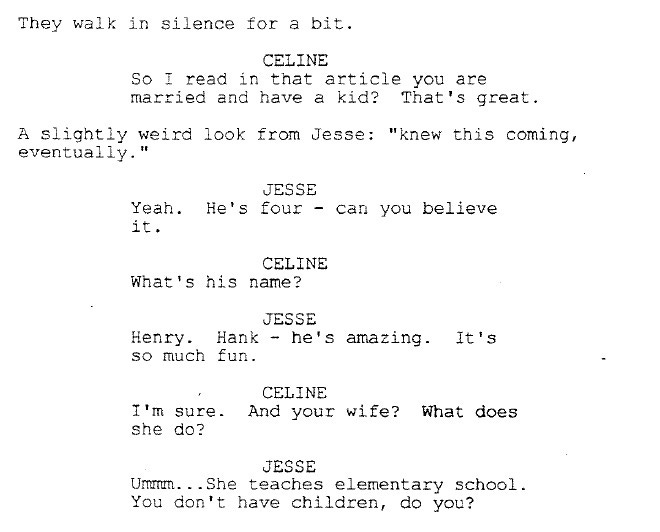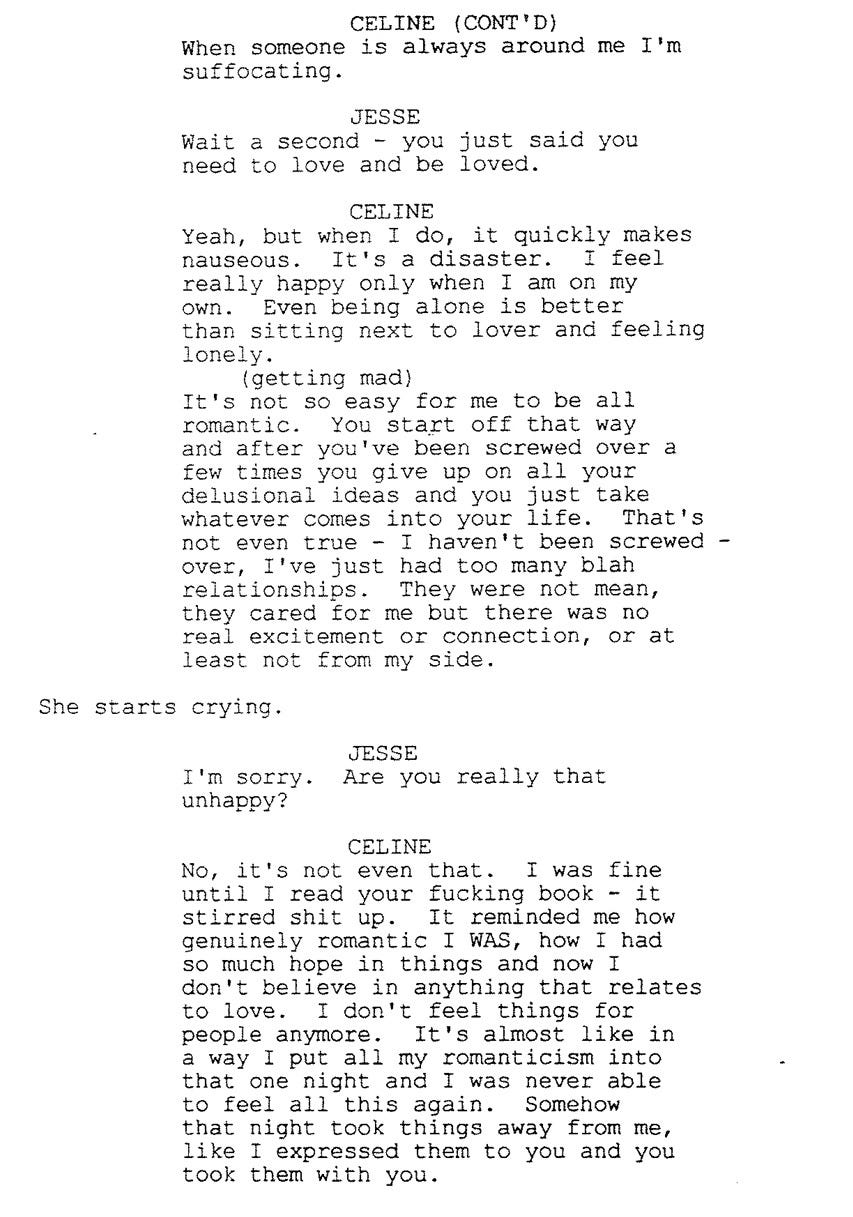Before Sunset (2004) Script Review | #39 WGA 101 Greatest Scripts of the 21st Century
A sublime and powerful follow-up to Richard Linklater's small romance story that is also a rare superior sequel.
Logline: Nine years after Jesse and Céline first met, they encounter each other again in Paris on the last leg of Jesse’s book tour, and try to see if their connection can be rekindled.
Written by: Richard Linklater, Ethan Hawke, & Julie Delpy
Based on: Characters created by Richard Linklater and Kim Krizan
Pages: 61
Scenes: 15
Before Sunset holds a special place in my heart. Maybe it has to do with its Parisian setting. Or maybe it’s due to being wiser and maturer in its view of love and romance. Reading the screenplay is an equally sublime experience, as two former lovers try to discover if the spark that brought them together can be reignited once more.
This unexpected sequel to Before Sunrise reunites Jesse and Céline nine years after their magical encounter on a train in Vienna. Jesse is in Paris, on the last leg of his book tour, and has to catch his plane back to the United States in less than an hour. But when Céline walks into the bookstore, Jesse is thrown for a loop. The two set off through the city, catching up on the last decade, sharing anecdotes and views about life. On the surface, their dialogue has all the appearance of an intelligent conversation; underneath, however, the dialogue is really an unspoken interrogation: Do you still like me? Is there another chance for us?
The script is a compact 61 pages; the resulting film is 90 minutes. Accordingly, one can break down the Before Sunset screenplay into three parts as follows:
Act 1: 1-26 (During which Jesse and Céline meet, go drink a coffee, and then continue to walk some more at Jesse’s invitation)
Act 2: 27-54 (During which Jesse and Céline begin to flirt, their conversation taking a slight sexual turn; their dialogue also becomes more personal, as they confess their unhappiness in life since they met in Vienna, and get vulnerable)
Act 3: 55-61 (During which Jesse persuades Céline to play him one of her songs before he has to leave for the airport)
Although the entire story seems simple, the execution is anything but. Richard Linklater and his co-stars, Ethan Hawke and Julie Delpy, turn the walk-and-talk between Jesse and Céline into a fencing match as they wield their words and thoughts like swords, each trying to get under the other’s armor. Each scene, each piece of dialogue, is carefully thought and written out. Believe it or not, the entirety of the Before Sunset screenplay consists of 15 scenes! Fifteen long scenes, but still, for a feature, that can feel surprisingly short.
Let’s break down each Act to see how the three writers make it work.
Act 1
Before Sunset opens with a series of images around Paris, establishing both the setting and the tone…
… though with the change that it would ultimately be Céline’s song that is used over the images, not Delerue as stated here. Another change is that the images would show all the places that these two would visit or travel through.
Jesse is at a bookstore, answering questions from the press about his modest book, based on that night in Vienna. It’s a clever move to naturally recap the events of the first film…
… and to also establish the idea of time; a theme that Linklater has always been obsessed with. It’s here, at the end of the press conference, that Céline reveals herself.
A slightly awkward greeting later, Jesse and Céline go to grab a coffee. Their dialogue here is cautious, a bit stiff. They are both hesitatingly stepping around each other because there is a question to be answered: did they ever meet again in December as planned at the end of Before Sunrise?
It turns out that they did not. Céline missed the trip because her grandmother died. Jesse did fly to Vienna but since he had no way of contacting her, he eventually flew back home. He jokes that his life has been downhill ever since, but even though he passes it off as a glib comment, he is not lying; but he doesn’t want to be vulnerable yet. Look, though, at how much they pack into the dialogue without making it seem forced.
The trick to writing realistic dialogue, ultimately, is to remember that it is not realistic— it only sounds realistic. There are no hesitations or filler sounds. They speak clearly, in fully formed thoughts and expressions, but with the cadence of people talking naturally.
Little by little, the two slide back into their old rhythms but it will take the entire script to get there. Still, there are promising signs. For instance, Jesse teases Céline about having Communist ideals or joking about something serious.
But tension exists, because the central question is: Will they fall in love again or not? Tension is also sustained by the pair deflecting questions that are too personal. Instead, they talk about their professions, their ideas, and stories as a substitute to gauge the other person’s interest. Seriously, in 20 pages, there is more substance than most scripts will contain in their entirety.
After finishing their coffee, Jesse asks Céline to continue walking with him because he wants to keep talking to her instead of being stuck at the airport. She accepts, and now they step into slightly deeper waters.
Act 2
Two things happen in Act 2. Actually, plenty happens, but I’m singling out two incidents in particular. The first is that sex creeps into their dialogue; it begins when Céline pretends that they didn’t actually sleep together in Vienna, and then later when she casually finds a way to ask about Jesse’s sexual interests. Sneaky!
The second is that conflict begins to appear more frequently. It’s subtle, but it’s there, and this helps to keep the tension sustained.
The Midpoint occurs around page 38, and that’s when the tenor and vibe begin to shift. It occurs when Céline raises the question about Jesse’s wife and son, something he hasn’t mentioned until then. Céline also mentions that she’s in a relationship. The constrained time is one obstacle; the two being committed to other people is an entire mountain to overcome.
Jesse is reluctant to leave, and prolongs his departure by convincing Céline to get on a boat traveling along the Seine. Tensions rise as they start sharing their vulnerabilities and frustrations about what might have been had they reconnected that December so many years ago. When they get into the car, their guards completely come down— but it’s also when the conflict reaches a boil around page 48-53. That’s when they finally reveal that their lives are a mess and that neither one has been the same since that night in Vienna. Jesse in particular is deeply unhappy in his marriage but stays for the sake of his small son.
Act 3
This is the shortest part of the script, a scant seven pages. One question has been answered: They still do love each other. But the problem remains that they are in other relationships. The question is: Will they act on their feelings?
To delay his departure—for the fifth time, mind!— Jesse persuades Céline to play one song on her guitar. Their walk up to her apartment is charged with tension.
In the script, nothing is mentioned about the song lyrics, except this one line…
… but they do insert the lyrics from Nina Simone’s ‘Just in Time.’ Despite the pressing need to go to the airport, Jesse makes no effort to hurry. Even though the ending remains ambiguous (until Before Midnight), it’s clear that being with Céline is where Jesse wants to be.
Both on page, and on screen, it leads to one of the most beautiful endings to a story.
It might surprise readers and fans of the Before trilogy that this version of Before Sunrise was not the initial idea that Linklater, Hawke, and Delpy had in mind for a sequel. Nor did they think it would take nearly a decade to get it made. An early idea for a sequel would have taken place shortly after the first film came out and set in the late 90s. But the story was more in the vein of a traditional romantic comedy, came with four locations, and required a bigger budget. Unable to raise the funding, the idea was shelved.
Sometime after, Linklater turned up to support Hawke at a book signing when he was struck by an idea: What if Céline met Jesse at a book signing? (Mind: this was before the age of social networks and social media; in a post-2004 world, they might have reconnected on Facebook). Hawke and Delpy picked up on this possibility, and soon, they began to work on the idea in earnest.
It turned out to be a collaborative process. The trio agreed that a scene proposed by anyone would only make the cut if all three approved; one rejection and out the window it went. They brought in autobiographical elements but Before Sunset is not autobiography (rumor has it that Jesse’s failing marriage was inspired by Hawke’s marriage to first wife Uma Thurman). Linklater, Hawke, and Delpy sat in a room and hammered out a detailed outline of the story in two-to-three days, followed by a year of emails and faxes (yep, people used faxes then!) going up and down between them. Hawke and Delpy would work on monologues, dialogues, scenes, and ideas, and like the control tower, Linklater would edit, compile, and stitch them together in one script.
As production began to move in earnest, they met in Paris to perform their first rewrite. This would continue well into rehearsals and pre-production until all three were satisfied that they’d nailed it. What looks improvised and spontaneous on the screen is carefully put down on the page; the end result of extensive rewrites, practice, and rehearsals.
One of the differences in this sequel is that the obstacles facing the older Jesse and Céline are obligations, appointments, and existing relationships. The long gap between the two stories allowed the writers to bring in a newer perspective; it is as much about falling in love all over again as it is about romantic projections and the cynicism that comes with age and time. It is a romance about romance. even though Jesse and Céline have deeper problems, they also have more experience to cope with them; yet they both struggle at the same time not to lose the ideals of their youth, and in turn, lose sight of themselves.
Before Sunset, as does the entire trilogy, owes a debt to one Amy Lehrhaupt. Linklater met her in 1989 and their night spent walking around Philadelphia inspired Before Sunrise. Unlike Jesse and Céline, Linklater and Lehrhaupt did stay in contact, but the troubles of a long-distance relationships caused the romance to fizzle out. Tragically, Lehrhaupt died in a motorcycle accident before the first film came out. One can consider these stories to be a tribute to her memory; it is yet more proof that inspiration really can come from anywhere. With Before Sunset, it becomes a reflective, sweet, yet more realistic take on love. Jesse and Céline may have lost a second chance in Vienna; but now, they’ll always have Paris.
Notes:
Wickman, Forrest (May 30, 2013) | The Real Couple Behind “Before Sunrise” (Slate)
Hoad, Phil (November 4, 2019) | Julie Delpy and Ethan Hawke: how we made the “Before Sunrise” trilogy (The Guardian)
Paris By Day (Filmmaker Magazine)



